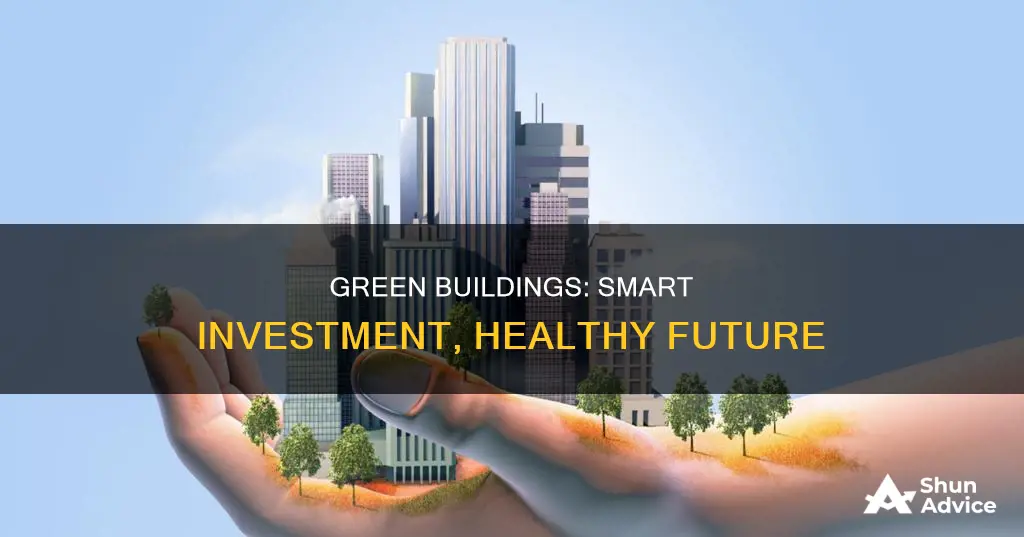
Green buildings are a critical part of the global fight against climate change and environmental protection. They are designed to reduce carbon emissions, conserve water, prioritise safer materials, and lower our exposure to toxins. Green buildings also reduce day-to-day costs, increase asset value, and promote health and well-being for their occupants. With the construction sector responsible for 37% of total energy-related carbon emissions worldwide, it is clear why there is a push for business sustainability and building projects that follow the triple bottom line: planet, people, and profit.
What You'll Learn

Green buildings are more profitable and cost-effective
Green buildings provide long-term economic and environmental benefits, and they appreciate local communities and the natural environment. They are designed with health, safety, and productivity in mind, and they are becoming increasingly popular with consumers, employees, and tenants.
Green buildings can save money by reducing energy and water use, and they can lower operational and maintenance costs over time. For example, the World Green Building Council report highlights how Cape Town's V&A Waterfront 2008 green retrofit saw a 17% drop in energy costs, and annual savings of US$62,000 and US$100,000 for water conservation and waste management, respectively.
Upfront investments in green buildings can increase property values, with building owners reporting a 10% or greater increase in asset value. Green buildings also reduce day-to-day costs, with LEED-certified buildings reporting lower maintenance costs than typical commercial buildings, and green building retrofits decreasing operation costs.
Green buildings are in higher demand, and owners can recoup the initial investment through higher occupancy and tenant attraction and retention rates. They also promote healthier indoor living environments, which is an appealing feature for homebuyers, especially in the post-COVID-19 era.
Renewables: Why the Reluctance?
You may want to see also

They reduce carbon emissions and energy use
Green buildings are an effective way to reduce carbon emissions and energy use. Buildings account for almost 40% of global energy-related CO2 emissions, so they play a major role in the transition to sustainability. Green buildings, through sustainable design, construction, and operations, are reducing carbon emissions and energy use.
A study by the Commission for Environmental Cooperation found that commercial and residential buildings in the US are responsible for 40% of primary energy consumption. The construction and insulation of environmentally sound buildings can significantly reduce the carbon footprint of buildings. The US Green Building Council estimates that green buildings reduce energy use by 30% and carbon emissions by 35%.
The use of wood in green buildings is an effective way to reduce energy consumption and carbon emissions. Wood products require less energy to produce than competitive construction materials such as plastic, metals, or concrete. The production of steel and concrete can require up to two times more energy than wood-based products. Wood is also a natural insulator for temperature and sound, and fire-retardant-treated wood insulation is more economical and environmentally friendly than fiberglass or polystyrene.
Green buildings also promote the use of renewable energy sources, such as solar and wind power, which can help reduce carbon emissions and energy use. Additionally, green buildings often have better insulation and energy-efficient appliances, which can further reduce energy consumption.
Overall, investing in green buildings is a way to reduce carbon emissions and energy use, contributing to the fight against climate change and promoting sustainability.
Investor Intentions: They Want to
You may want to see also

They improve health and well-being
Green buildings are designed to improve the health and well-being of their occupants. They do this by creating optimised environments with better air quality and natural lighting, which have been shown to reduce stress and improve productivity and creativity in the workplace.
A growing body of research highlights the positive impact of green buildings on occupant health. A 2017 study by Harvard University, Syracuse University and SUNY Upstate Medical University found that participants in green office environments were more productive than those in conventional buildings. The study also showed that those working in well-ventilated environments had the highest levels of cognitive function.
Green buildings also tend to incorporate natural elements, such as living plants, green walls, timber exteriors, and patterns and colours that evoke nature. This biophilic design has been found to reduce stress and improve productivity. In addition, green buildings may provide healthier diet options, encourage physical activity, and offer spaces for relaxation and detoxification, such as yoga rooms or sleeping pods.
The benefits of green buildings extend beyond the individual, as they also contribute to public health. By improving indoor air quality, they can reduce absenteeism due to asthma, respiratory allergies, depression, and stress. This leads to improved productivity and a happier, healthier workforce.
Overall, investing in green buildings demonstrates a commitment to the well-being of occupants, whether they are employees, tenants, or homeowners. By prioritising health and well-being, green buildings create spaces that not only promote sustainability but also enhance the human experience within them.
Diversification: Investors Seek Safer Havens
You may want to see also

They increase marketability and asset value
Green buildings are becoming increasingly marketable and valuable. A report from the World Green Building Council (WorldGBC) highlights the numerous benefits of green buildings, including their ability to recoup investments through operational cost savings.
Green buildings are becoming more valuable as investors and occupants become more aware of and concerned about the environmental and social impacts of the built environment. As a result, buildings with better sustainability credentials are more marketable and can command higher rents and sale prices.
Green buildings can reduce operational costs by saving energy and water and lowering long-term operations and maintenance expenses. These savings can offset any cost premiums associated with their design and construction. For example, LEED-certified buildings have been shown to have almost 20% lower maintenance costs than typical commercial buildings, and green building retrofits can decrease operation costs by almost 10% in a year.
The University of Texas at Austin found that homes built to LEED standards between 2008 and 2016 showed an 8% boost in value, while homes built to a wider range of green standards saw a 6% increase. Green labels and certifications, such as LEED, WELL, and Living Building Challenge, can further improve a property's marketability and desirability.
Additionally, green buildings can improve worker productivity and occupant health and well-being, resulting in bottom-line benefits for businesses. They can also reduce the risk of regulatory non-compliance, as more countries and cities implement mandatory disclosure, building codes, and laws banning inefficient buildings.
Human Capital: The Investment in People
You may want to see also

They promote business transparency and sustainability
Green buildings promote business transparency and sustainability by reducing environmental impacts and promoting clean, healthy, and comfortable indoor environments. They also contribute to economic growth and improve the well-being of employees and the wider community.
Reducing Environmental Impacts
Green buildings aim to minimize their environmental footprint throughout their entire life cycle, from planning and design to construction, operation, maintenance, renovation, and eventual demolition. This involves reducing energy consumption, using renewable energy sources, conserving water, minimizing waste, and lowering carbon emissions. By adopting green building practices, businesses can reduce their impact on the environment, contribute to global carbon reduction goals, and address the pressing issue of climate change.
Promoting Clean, Healthy, and Comfortable Indoor Environments
Green buildings prioritize the use of safer and less toxic materials, improving indoor air quality and reducing exposure to pollutants. This has a direct impact on the health and well-being of occupants, reducing absenteeism and improving productivity. Green buildings also incorporate natural elements, such as daylight and indoor gardens, which have been shown to enhance employees' sense of well-being and productivity.
Contributing to Economic Growth
Green buildings offer economic benefits, including reduced operating costs, shorter payback periods, and increased asset value. They also create jobs and contribute significantly to the economy. Green building practices can enhance a company's public image and build trust with consumers, employees, and investors. This trust is essential for long-term business success and can lead to increased marketability and profitability.
Improving Employee and Community Well-being
By prioritizing sustainability and transparency, businesses can improve the well-being of their employees and the wider community. Green buildings promote healthier living environments, reduce indoor air pollutants, and enhance overall comfort. This not only benefits the occupants of the building but also contributes to the health and resilience of the surrounding community.
In summary, investing in green buildings promotes business transparency and sustainability by reducing environmental impacts, creating healthy indoor spaces, driving economic growth, and improving the well-being of employees and communities. These benefits work together to create a more sustainable and resilient future for businesses and society as a whole.
Starbucks: A Brew Worth Betting On
You may want to see also
Frequently asked questions
Green buildings are an effective solution to reducing carbon emissions, energy and water use, and waste. They also help conserve water, prioritize safer materials, and lower exposure to toxins.
Green buildings can help businesses by reducing operational and maintenance costs, increasing asset value, and attracting and retaining employees.
Green buildings can improve employee satisfaction, productivity, and overall health and well-being. They also provide healthier indoor air quality and promote clean air and water.
Green buildings address the negative impact of the construction industry on the environment by reducing energy consumption, using renewable energy sources, minimizing waste, and utilizing environmentally friendly materials.
Green buildings have the potential to increase asset value and marketability. They may also qualify for preferential insurance and loan rates and provide long-term cost savings, making them a financially viable option.







